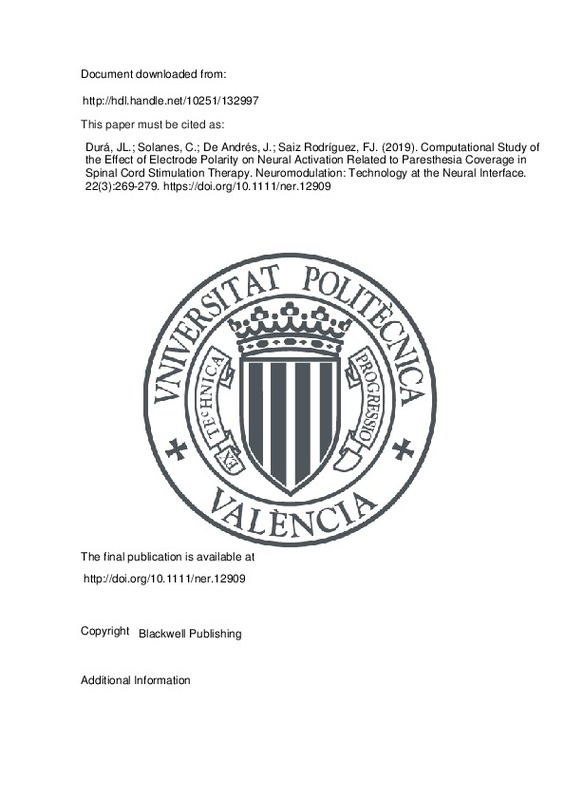JavaScript is disabled for your browser. Some features of this site may not work without it.
Buscar en RiuNet
Listar
Mi cuenta
Estadísticas
Ayuda RiuNet
Admin. UPV
Computational Study of the Effect of Electrode Polarity on Neural Activation Related to Paresthesia Coverage in Spinal Cord Stimulation Therapy
Mostrar el registro sencillo del ítem
Ficheros en el ítem
| dc.contributor.author | Durá, José L.
|
es_ES |
| dc.contributor.author | Solanes, Carmen
|
es_ES |
| dc.contributor.author | De Andrés, José
|
es_ES |
| dc.contributor.author | Saiz Rodríguez, Francisco Javier
|
es_ES |
| dc.date.accessioned | 2019-12-15T21:01:11Z | |
| dc.date.available | 2019-12-15T21:01:11Z | |
| dc.date.issued | 2019 | es_ES |
| dc.identifier.issn | 1094-7159 | es_ES |
| dc.identifier.uri | http://hdl.handle.net/10251/132997 | |
| dc.description.abstract | [EN] Objective: Using computer simulation, we investigated the effect of electrode polarity on neural activation in spinal cord stimulation and propose a new strategy to maximize the activating area in the dorsal column (DC) and, thus, paresthesia coverage in clinical practice. Materials and Methods: A new three-dimensional spinal cord model at the T10 vertebral level was developed to simulate neural activation induced by the electric field distribution produced by different typical four-contact electrode polarities in single- and dual-lead stimulation. Our approach consisted of the combination of a finite element model of the spinal cord developed in COMSOL Multiphysics and a nerve fiber model implemented in MATLAB. Five evaluation parameters were evaluated, namely, the recruitment ratio, the perception and discomfort thresholds, and the activating area and depth. The results were compared quantitatively. Results: The dual-guarded cathode presents the maximum activating area and depth in single- and dual-lead stimulation. However, the lowest value of the ratio between the perception threshold in DC and the perception threshold in the dorsal root (DR) is achieved when the guarded cathode is programmed. Although the two versions of bipolar polarity (namely bipolar 1 and bipolar 2) produce higher activating area and depth than the guarded cathode, they are suitable for producing DR stimulation. Similarly, dual-lead stimulation is likely to activate DR fibers because the electrodes are closer to these fibers. Conclusions: The results suggest that the activating area in the DC is maximized by using the dual-guarded cathode both in single- and dual-lead stimulation modes. However, DC nerve fibers are preferentially stimulated when the guarded cathode is used. According to these results, the new electrode programming strategy that we propose for clinical practice first uses the dual-guarded cathode, but, if the DR nerve fibers are activated, it then uses guarded cathode polarity. | es_ES |
| dc.description.sponsorship | The authors thank Virginie Callot for providing us with all the spinal cord measurements from her research group’s study. The authors would like also to thank Surgicen S.L. for providing financial assistance | es_ES |
| dc.language | Inglés | es_ES |
| dc.publisher | Blackwell Publishing | es_ES |
| dc.relation.ispartof | Neuromodulation: Technology at the Neural Interface | es_ES |
| dc.rights | Reserva de todos los derechos | es_ES |
| dc.subject | Computational model | es_ES |
| dc.subject | Dorsal column stimulation | es_ES |
| dc.subject | Dorsal root stimulation | es_ES |
| dc.subject | Electrode polarity | es_ES |
| dc.subject | Spinal cord stimulation | es_ES |
| dc.subject.classification | TECNOLOGIA ELECTRONICA | es_ES |
| dc.title | Computational Study of the Effect of Electrode Polarity on Neural Activation Related to Paresthesia Coverage in Spinal Cord Stimulation Therapy | es_ES |
| dc.type | Artículo | es_ES |
| dc.identifier.doi | 10.1111/ner.12909 | es_ES |
| dc.rights.accessRights | Abierto | es_ES |
| dc.contributor.affiliation | Universitat Politècnica de València. Departamento de Ingeniería Electrónica - Departament d'Enginyeria Electrònica | es_ES |
| dc.description.bibliographicCitation | Durá, JL.; Solanes, C.; De Andrés, J.; Saiz Rodríguez, FJ. (2019). Computational Study of the Effect of Electrode Polarity on Neural Activation Related to Paresthesia Coverage in Spinal Cord Stimulation Therapy. Neuromodulation: Technology at the Neural Interface. 22(3):269-279. https://doi.org/10.1111/ner.12909 | es_ES |
| dc.description.accrualMethod | S | es_ES |
| dc.relation.publisherversion | http://doi.org/10.1111/ner.12909 | es_ES |
| dc.description.upvformatpinicio | 269 | es_ES |
| dc.description.upvformatpfin | 279 | es_ES |
| dc.type.version | info:eu-repo/semantics/publishedVersion | es_ES |
| dc.description.volume | 22 | es_ES |
| dc.description.issue | 3 | es_ES |
| dc.relation.pasarela | S\391137 | es_ES |
| dc.contributor.funder | Surgicen, S.L. |







![[Cerrado]](/themes/UPV/images/candado.png)

